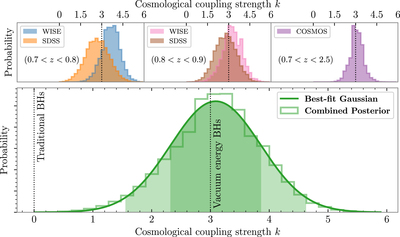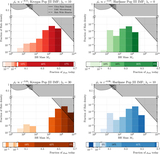Image Details

Caption: Figure 1.
(Top) Posterior distributions of cosmological coupling strength k, inferred by comparing supermassive black holes (BHs) in local elliptical galaxies to those in five samples of elliptical galaxies at z > 0.7. (Bottom) Combining these posterior samples with equal weighting gives a distribution with ﹩k={3.11}_{-1.33}^{+1.19}﹩ at 90% confidence. If fit to a Gaussian, the fit has a mean of k = 3.09 with a standard deviation of 0.76 (shading). Vertical lines indicate: k = 0 coupling, as expected for traditional BHs like Kerr and the decoupled solution by Nolan (1993); and k = 3 coupling, as predicted for vacuum energy interior BHs. The measurement disfavors zero coupling at 99.98% confidence and is consistent with BHs possessing vacuum energy interiors, as first suggested by Gliner (1966).
Copyright and Terms & Conditions
© 2023. The Author(s). Published by the American Astronomical Society.





